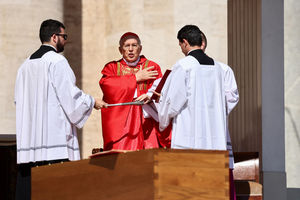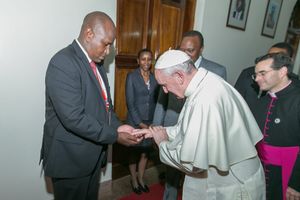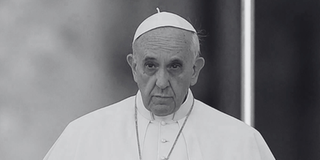
It is finished. Jorge Mario Bergoglio, better known as Pope Francis, has shuffled off this mortal coil, aged 88. Neither with fanfare nor a dramatic celestial intervention, but likely with the quietude befitting a man who made a career out of simplicity.
The world, of course, performs its usual paroxysms of grief and commentary – the rolling news channels dusting off their Vaticanologists and newspaper opinion pages groaning under the weight of instant legacy assessments.
It’s the standard operating procedure when the man in the big hat checks out of the big house. But beneath the predictable global theatre, the mourning – some of it choreographed – and the curated soundbites, lies the complex, contradictory story of a man, who was arguably the most unlikely Pope in centuries. He was an outsider, who rode into Rome and tried to tidy up things.
Francis’s death, like his papacy, invites not so much reverence as a critical squint, a deconstruction. He was a figure riddled with the sort of contradictions that make for a good story – the humble servant who wielded immense power; the man of the people who presided over a notoriously opaque institution and the reformer who often seemed constrained by the system he sought to change. A life less beatific, perhaps, than bafflingly human, played out on the world’s most ornate stage.
The narrative arc is almost too neat, ripe for the hagiography that inspires. Born in Buenos Aires to Italian immigrants, he was a railway worker’s son in a working-class barrio — not the usual princelling groomed in seminaries.
He started out not wrestling with angels on a pinhead but with beakers and Bunsen burners, graduating as a chemical technician, even doing stints as a bouncer and janitor.
Then, a Damascene conversion happened, reportedly sparked by a confession on the way to celebrate Spring Day, though perhaps accelerated by a bout of pneumonia that cost him part of a lung around age 21.
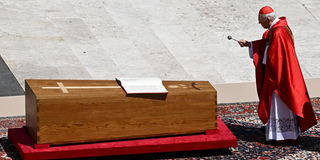
Cardinal Giovanni Battista Re blesses the coffin as he leads the funeral Mass of Pope Francis, in Saint Peter's Square, at the Vatican, April 26, 2025.
He threw in his lot with the Jesuits, the Church’s intellectual shock troops known for their rigorous training, loyalty and a certain reputation for subtle manoeuvring.
He wasn’t just any Jesuit; he rose through the ranks, becoming Provincial Superior for Argentina from 1973 to 1979. His tenure coincided with the years of Argentina’s “Dirty War”, when the junta disappeared, tortured and murdered thousands.
Accusations have swirled. Did Fr Bergoglio do enough to protect priests who were abducted and tortured after working in the slums? Some say he failed by colluding with the regime. Others paint a different picture, a clandestine operation worthy of a Cold War thriller: Bergoglio as an Argentine Schindler, hiding people in seminaries, providing false papers, even giving one man his passport and clerical garb to facilitate escape. Witnesses like Alicia Oliveira attest to his courage in helping the persecuted.
Bergoglio maintained his innocence, saying he did what he felt he had to do, navigating a treacherous path, and pointing to official investigations that cleared him. The Argentine bishops’ conference recently published documents aiming for clarity.
Yet, the ambiguity lingers, a stain on the Papal soutane. It speaks volumes about the impossible choices faced under tyranny, the murky compromises of institutional survival and the difficulty of judging actions taken under the shadow of the gun.
It’s a reminder that sainthood, or even basic decency, looks different when death squads of the Argentine anti-communist alliance are cruising the streets and your colleagues are disappearing.
His subsequent career – bishop, archbishop of Buenos Aires in 1998, cardinal in 2001 – saw him cultivate a reputation for austerity, riding the bus, living in a simple apartment, championing the poor in the villas miseria.
Elected in 2013 after the conservative Benedict XVI did the unthinkable and resigned, Bergoglio arrived like a gust of wind through the fusty corridors of the Vatican: the first Pope from the Americas, the first Jesuit, the first non-European in more than a millennium.
His choice of name – Francis, after the Poverello of Assisi – was a stroke of branding genius (Franciscans are markedly less doctrinaire than Jesuits), instantly signalling a break from the more monarchical style of his predecessors.
Out went the massive papal apartments in the Apostolic Palace, swapped for the suite in the Casa Santa Marta, the Vatican guesthouse.
Leather loafers
The golden pectoral papal cross was rejected for his far simpler iron one, the one he had as archbishop of Buenos Aires; and the famous red leather loafers ditched for his own worn orthotics.
He moved around in modest cars, eschewing the bulletproof Popemobile whenever possible.
Was the humility genuine? It was undeniably effective. In an era suspicious of institutional power and wealth, Francis’s calculated modesty resonated. He understood, better than his predecessors, that in the 21st century, true authority might lie not in ostentation but in its apparent rejection.
Of course, the contradiction remained that the champion of the poor presiding over an institution sitting on a millennium of accumulated wealth, art treasures and prime real estate while grappling with Byzantine finances that seemed perpetually mired in scandal.
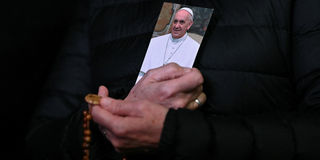
A person holds a picture of Pope Francis and a rosary during a prayer service at St. Peter's Square, as Pope Francis continues his hospitalization, at the Vatican, February 25, 2025.
He preached against the “idolatry of money” while his house struggled to balance its books and root out corruption. It’s a paradox sharp enough to cut glass.
Leading a multinational spiritual corporation while dressing like a parish priest is a tightrope walk performed daily, under the gaze of a billion faithful and a sceptical world.
Beyond the carefully built image, Francis had things to say. His papacy was marked by pronouncements and initiatives aimed at repositioning the Church on the global stage.
Mercy was the watchword, encapsulated in his off-the-cuff remark about gay priests: “Who am I to judge?”. It was a phrase that signalled a potential softening of the Church’s harsh stance, even if concrete doctrinal changes remained elusive.
He approved blessings for same-sex couples, provided they didn’t resemble marriage vows – a typically Jesuitical distinction that annoyed conservatives without fully satisfying progressives. He made the plight of migrants and refugees a central theme, denouncing the “globalisation of indifference” on his first trip outside Rome to Lampedusa.
He prayed at the US-Mexico border, brought Syrian Muslim asylum-seekers back to Rome on the papal plane and advocated for welcoming the stranger, often putting him at odds with Western governments which were removing welcome mats and wrapping themselves in razor wire. It was a stance rooted in the Gospels, certainly, but one delivered with an understanding of contemporary moral pressure points.
Then there was “Laudato Si”, his 2015 encyclical on the environment. Subtitled “On Care for Our Common Home”, it was a sprawling, sometimes poetic, treatise calling for an “integral ecology”.
It linked environmental degradation to social injustice, critiqued consumerism and the “technocratic paradigm”, and urged a conversion of hearts and minds.
Paris Climate Accord
It was praised by environmentalists and credited with boosting momentum for the Paris Climate Accord. Yet, one wonders how much impact a papal letter has on the relentless machinery of global capitalism or the habits of consumption. It generated headlines, certainly, but changing the world requires more than just eloquent theology.
His efforts at inter-faith dialogue were notable, continuing the work of his predecessors but with a distinctive style. Francis met the Russian Orthodox Patriarch Kirill in Cuba, made a trip to Iraq to meet Grand Ayatollah Ali al-Sistani, fostered ties with Jewish communities and signed a document on “Human Fraternity” with the Grand Imam of Al-Azhar.
These gestures were of symbolic weight, attempts to position the Church not as an isolated fortress but as a player in a complex, pluralistic multi-faith world. Whether these handshakes and declarations translate into lasting understanding, or are merely diplomatic niceties, remains an open question.
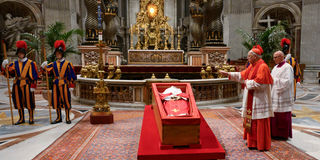
The body of Pope Francis lies in a casket before it's sealed, at St. Peter's Basilica, ahead of his funeral at the Vatican, April 25, 2025.
For all the talk of mercy and dialogue, Francis’s papacy was rocked by storms, many inherited, some self-inflicted. The clergy sexual abuse crisis, a cancer metastasising within the Church for decades, exploded anew.
His initial handling of the situation in Chile was a disaster. He defended a bishop accused of covering up abuse and accused victims of slander. The backlash was fierce, forcing a climb-down.
He admitted “grave errors” in judgment, summoned the Chilean episcopate to Rome to demand their resignations and met victims to apologise.
He took decisive action against disgraced American cardinal Theodore McCarrick, defrocking him after a Vatican investigation confirmed allegations of abuse of children and adults.
He convened a global summit on child protection and introduced church laws requiring internal reporting of abuse and establishing procedures for investigating bishops. He even abolished the “pontifical secret” in abuse cases, theoretically allowing more cooperation with civil authorities.
Yet, criticism persisted. The McCarrick report, when finally released, seemed to spread the blame widely while exonerating Francis. Victims’ groups continued to demand greater transparency and accountability, arguing that the culture of cover-up remained entrenched.
The crisis exposed the limits of papal authority and the sheer stubborn inertia of the clerical system.
Francis also faced opposition from within his ranks. His 2016 exhortation “Amoris Laetitia”, which cautiously opened a door for divorced and remarried Catholics to receive communion in certain cases after discernment, provoked uproar among conservatives.
Four cardinals issued a formal challenge, a set of dubia (doubts), demanding yes-or-no answers on whether the document contradicted established doctrine, particularly John Paul II’s “Veritatis Splendor”. Francis refused to answer directly, deepening the rift.
This discontent culminated in the intervention of Archbishop Carlo Maria Viganò, a former Vatican diplomat. In 2018, Viganò released an 11-page letter accusing Francis and other officials of covering up McCarrick’s abuses and demanding the Pope’s resignation.
The letter, amplified by sympathetic conservative Catholic media outlets, caused a sensation, particularly in the United States. While Viganò’s credibility was questioned – he had a history of grievances and later embraced increasingly conspiratorial views – his accusations laid bare the ideological divisions and personal animosities within the Church hierarchy.
Power struggle
It wasn’t just a theological debate; it was a barely concealed power struggle; a Vatican civil war fought with accusations and leaked documents. Adding to the turbulence were the struggles to reform the Vatican’s murky finances.
Francis arrived with a mandate for change, establishing bodies like the Secretariat for the Economy, introducing new procurement laws and attempting to bring transparency and accountability to entities like the Vatican Bank and the Administration of the Patrimony of the Apostolic See.
Yet progress was slow, hampered by resistance and scandals, like the trial involving Cardinal Angelo Becciu over a London property deal.
Francis repeatedly urged cardinals and departments to tighten their belts and aim for a “zero deficit”, but untangling decades of opaque practices and vested interests proved a Herculean, perhaps impossible task.
So, what remains? Did the man from Buenos Aires truly change the Church or just give it a temporary facelift? There is no denying his global popularity, at least initially. He generated a measurable phenomenon dubbed the “Francis effect”.
Studies showed that following the release of Laudato Si’ and his US visit, more Americans, particularly Catholics, reported increased concern about climate change and saw it as a moral issue.
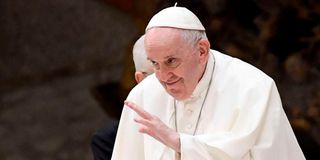
Pope Francis.
His message seemed to resonate, activating those already concerned and framing the issue in compelling moral terms.
But the effect had limits. It was most pronounced among those already inclined to agree with him. Political conservatives, even Catholic ones, remained unmoved on climate change, suggesting that tribal political identities often trump religious affiliation.
Read: ‘His last appearance was a sacrifice’: Highlights of the sermon delivered at Pope Francis’ burial
The Pope’s moral authority, however potent, struggled to penetrate the echo chambers of a polarised world. His influence seemed more effective at changing the conversation than fundamentally changing minds or policies on a grand scale.
It was, perhaps, a brilliant exercise in raising awareness but this alone doesn’t power down coal plants or rewrite international treaties.
His legacy might ultimately be defined less by the changes he implemented and more by the resistance he provoked.
Contemporary Catholicism
He exposed the deep fault lines within contemporary Catholicism – the chasm between a pastoral approach emphasising mercy and accompaniment and a traditionalist wing demanding doctrinal clarity and adherence to rules; the tension between the burgeoning Church of the Global South and the old European power centres; the ongoing struggle to reconcile ancient teachings with modern realities.
Francis did not create these divisions, but his papacy brought them into sharp, often uncomfortable, relief.
In the end, Jorge Bergoglio was a man caught between worlds: the gritty realities of Buenos Aires and the gilded cage of the Vatican – between the Jesuit call for engagement with the world and the papal demand for institutional preservation, between the impulse towards reform and the immense weight of tradition.
He arrived as an outsider, promising fresh air, and for a time, it seemed he would actually clear out the Augean stables.
Pope Francis spoke a language of humility and mercy that captivated many, tired of clerical arrogance and judgment.
But institutions, especially one as large as ancient and complex as the Catholic Church, have a way of resisting change, of absorbing reformers and grinding them down.
He tackled the finances, but the ledgers remained stubbornly unbalanced. He addressed the abuse crisis, but the scars and the suspicion remain.
Francis offered a more welcoming tone on some social issues, but doctrine remained largely untouched.
He generated an international buzz, but the “Francis Effect” proved more ephemeral than transformative.
Was he a revolutionary constrained by circumstance, or a canny operator who knew precisely how far he could push the envelope without crossing the boundaries?
Was he St Francis of Assisi reborn or just a clever politician in a white cassock?
Perhaps he was simply a man trying to steer a large unwieldy ship through stormy seas, patching leaks and adjusting the sails as best he could, while factions below deck fought over the route she should chart.
The first Pope from the Global South, he represented a potential shift in the axis of the Church, a challenge to its Eurocentric past.
But the final verdict on whether that shift will endure, or whether the institution will revert to type, will be written by his successor.
The gaucho has ridden off into the sunset; the saloon doors swing shut, leaving behind a sense of unfinished business and the faint, unsettling aroma of incense and ambiguity.
